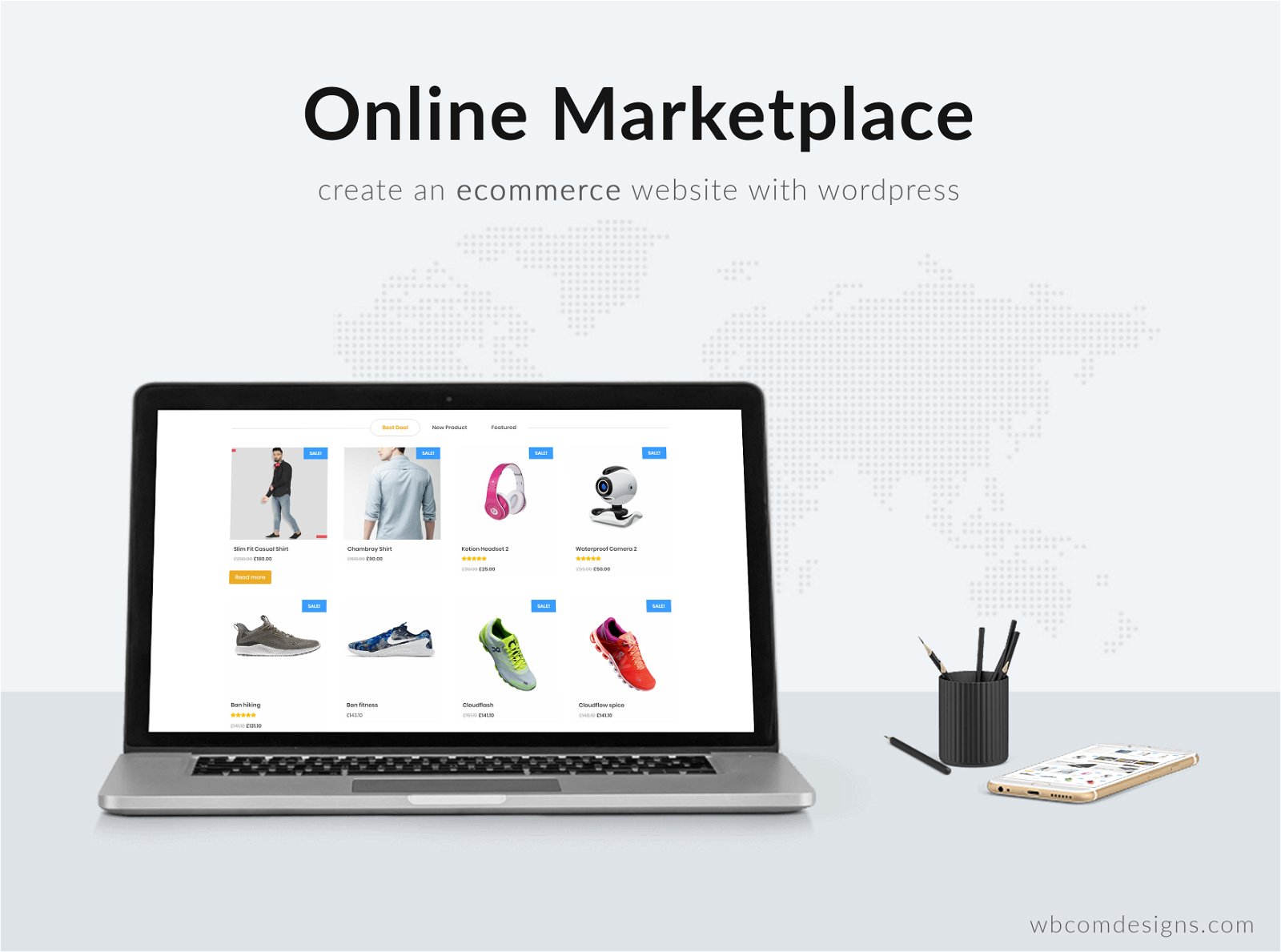Just as massive physical malls have forced out shops with a narrow focus, marketplaces with multiple vendors are pushing in the direction of unpretentious online stores. What do we observe? Some sellers simply close their websites and take advantage of the strength of the eCommerce giants. They can sell their products on multi-vendor marketplace website like Etsy, eBay, Amazon, and Etsy. Other companies invest heavily in their online stores, so as not to fall victim to this intense competition.
The most ambitious online sellers take advantage of the current trend and develop multi-vendor sites.
To help you understand how to set up an online multi-vendor marketplace website and cut down on research, we’ve developed an easy-to-follow plan. This guide for beginners on creating a multi-vendor site contains everything you need to know before and during launch.
Learn about the different types of markets that exist, and you’ll see some popular multi-vendor websites examples. We’ll also explain the benefits and drawbacks of the business model based on marketplaces, the most important features of multi-vendor eCommerce applications, and the steps for growth.
Table of Contents
ToggleWhat is a Multi-Vendor Marketplace Website?

In simple terms, it is a website with offerings from many sellers, vendors, or suppliers.
All suppliers pay a fair commission to sell their products on the market. They have accounted for sellers which manage their inventory by themselves. However, it’s the marketplace owner who handles every transaction. This is a win-win situation, since the owner of the multi-vendor marketplace receives inventory, while sellers receive buyers.
Simply put, the process of launching a multi-vendor marketplace website is like making a marketplace similar to Amazon or eBay with your own. I hope it’s clearer now.
In most cases, the term eCommerce marketplace is often associated with disruption, which is altering how the market operates. Simply put, markets that are not served are served, while those that are served too much start to provide an improved or less expensive product, and a better experience for customers.
Of course, establishing and running a virtual marketplace isn’t identical to one vendor’s store. store (opens in an entirely brand new window). There are many distinctions. With distinct business opportunities, the multi-seller marketplace operator is faced with new issues.
Also Read: 6 Tips To Re-design Your WordPress Site With Minimal Downtime
Why Opening a Multi-vendor Marketplace Website is a Good Idea?
Apart from providing better service for customers, multi-vendor stores also provide new opportunities and advantages to companies. What’s the reason would you ever consider starting your online marketplace or shifting to this model of business from an eCommerce store that is solely a single vendor?
- In the first place, you must be aware of There is no longer a need to manage or invest in inventory. Marketplace operators earn commissions for transactions, while vendors handle their products, which implies:
- There are fewer financial risks since you don’t have to invest in the inventory of your website.
- There are fewer management tasks since vendors handle and ship their products. However, you’ll need to be aware of the management of the vendor.
- More time and money to invest in growth, development, and promotion.
Supply expansion is simpler and faster.
-
- It is possible to begin selling new products and categories by accepting new vendors without any risk and with an exhaustive demand analysis.
- There are sellers with small sizes who are unable to sell their inventory, and it’s expensive to manage their website. These sellers will be happy to offer their products via your market.
You’ll see more buyers.
-
- An extensive selection of goods and experiences will draw many more visitors to your eCommerce site, which will bring more sellers.
- Customers consider large marketplaces to be more secure than smaller online stores and will be more inclined to complete an online payment.
- Multi-vendor marketplace website create a new buyer-seller relationship and are an effective and reliable method for communication between their users.
- The competition in online marketplaces drives sellers to lower their prices. Customers love bargains.
It is easier to market your site.
-
- Your sellers will turn into your brand ambassadors, especially those who only sell through your marketplace. They will post news about their listings, which will draw new buyers to your eCommerce website.
- If you operate a niche market this solves the problem of choosing the appropriate market to focus on. You offer products to specific groups of customers. You know the demographics of them, how to reach them, and what advantages your business can offer them.
- An extensive selection of products that can meet the requirements of a certain segment of the market is what makes you a top player in this field.
- Marketplace business models increase the chances of starting international sales because you can welcome buyers and sellers from all over the world.
- eCommerce Marketplace is more likely to attract funds. Websites built on these business models have higher chances of growth, which is why the investors are attracted to them.
- The growth of your company can result in new and exciting productive partnerships.
- You can effectively blend several business models when you operate an extensive marketplace. Sell both services and products, as well as let companies and clients offer their services to each other.
- Network Effect will offer a great service to your market with regards to scaling if you can locate an appropriate one. Simply put the essence of the effect of the network is each new user adds value to your marketplace to the other users. This is why users begin shopping on your market. Social networks are a shining example of the value of this. The more people join the network the greater number of friends they can make. The more interesting content by different authors is posted as well as the more people you can share information with, etc.
For eCommerce online There are a variety of network impacts
- Buyers gain from the buyers. They can see how often the item was purchased, and read the reviews of other buyers and, consequently, be able to pick the best seller from the many available on the market.
- Customers benefit from sellers. The more sellers begin selling on the market, the more choices customers will have.
- Additionally, vendors profit from the vendors. More sellers result in registrations of more buyers. This creates an eCommerce market more beneficial for other sellers. Additionally, the more people sign up on a marketplace, the higher the likelihood of it growing. For instance, because of the popularity of Uber that drivers from more cities and countries sign up for the app, which means that users receive more efficient service since everywhere they travel, they’re aware of how to access an Uber.
How to Create a Multi-Vendor Marketplace
Leaping eCommerce may seem like an enormous leap. One method to ease the process is to share your audience and costs with similar companies.
This configuration referred to as a multi-vendor marketplace is a storefront shared for many sellers on a single website. Each seller within the community can design or edit their product. Customers can add any combination of items into their carts and pay for all purchases in one transaction.
It’s an excellent option for small businesses to get some extra assistance when it’s just starting out or for stores that are already in operation to expand their business.
Multi-vendor is a community that includes the sellers as well as the customers

The most significant benefit of a multi-vendor market is the connection with other entrepreneurs. Shops you collaborate with form an integral part of your network. They can answer your questions and assist in navigating the growth and sales challenges and you’ll be able to transfer your knowledge to the next generation of entrepreneurs.
Sharing one shopfront means that you’re sharing customers as well. You’re creating a bigger brand by connecting sellers who share the same visions and audiences. Join forces with sellers who offer products that your customers will love and whose customers would be thrilled with your product as well.
With everyone gathered under one company, you can form your communities. Your website as well as the social media feeds are locations where customers with similar desires gather. It is also where you can connect with and learn from them.
Multi-vendor benefits for marketplace owners
If you manage and own the WooCommerce website many advantages come with establishing multi-vendor:
1. Another source of income
If you allow new vendors to your market, you could receive a fee on every sale they make. Set a common commission rate for all of the sites or give sellers various rates that are tied to specific requirements like a variety of items and an established audience. Be transparent about your transaction fees and let them help to fund your overall maintenance expenses.
2. An increased market
As new sellers join your platform, they will bring new types of customers. Ideally, you’ll select sellers who all offer complementary products. If you’re planning to make the theme of a home chef looking for merchants that offer kitchenware and other gadgets, but not necessarily the same things. Maybe some offer towels, others customized knives, and some baking pins, rolling pins, or other bakeware. Each vendor has their accounts on social media along with word-of-mouth contacts, as well as an established customer to bring customers to your market. The more vendors you have, the greater number of customers you can offer to all of us.
3. Complete control over members
As the marketplace owner, you have the final say of the content displayed on your website. When new companies submit applications to join, you can select only those that align with the overall look and feel you’re trying to build. Accepted vendors can create their products within the WooCommerce dashboard however, you must ensure quality control, and only products you’ve approved are allowed to be published on the website.
4. Automated payments
Worried about calculating complex payments for every seller? Don’t be. Utilize this WooCommerce Product Vendors extension to set up automatic payments with PayPal according to the schedule you’d prefer. Keep payments in place until your orders are fully completed and all period of return has expired and then automatically pay vendors for each sale, bi-weekly or monthly.
5. Shared the responsibility
Spread the responsibility of managing and maintaining your site by assigning administrators who will have the authority over the store. Your new admin team will be in a position to approve suppliers and products and handle password issues and handle featured products for you while you focus on what you enjoy: making as well as selling your merchandise.
Benefits of multi-vendor selling for sellers
Multi-vendor sites are great for retailers as well: They’ll gain immediate access to a large audience and won’t need to put in the cost or effort of building an entire website completely from scratch. However, that doesn’t mean they’re in a bind. If they sign up to your marketplace, they’ll have the ability to:
1. Create your products and manage their stock
Vendors have limited access to the WordPress dashboard to design products and upload images, determine prices and describe their products in the most precise method. Vendors are also able to manage their inventory numbers making sure that availability is precise and immediately updated for visitors customers.
2. They can set their shipping rates
Vendors have the option of setting their shipping costs for their products, meaning they don’t have to adhere to an exact pricing system for products that are heavy, bulky, or need additional shipping.
3. Notes from customers
Order confirmation emails may include vendor notes, which means sellers can directly address their clients. Emails can contain delivery details and instructions as well as mandatory disclaimers with their language and with no full access to the administrative side.
4. Download specific sales data
Vendors can see their own sales figures and customer data in an easy-to-read format, within WooCommerce’s dashboard. WooCommerce dashboard. The data they collect can be used to ensure that they’re listing the correct items in the right spots, and also to guide the marketing strategies they’ve created for themselves.
5. Sell everything
With WooCommerce sellers can sell physical products, digital downloads, or both. With extensions, you can offer more choices. One of the most popular options is WooCommerce Bookings that let your vendors sell appointments and consultations.
What do you need to Create with an Online Marketplace using WordPress?

The first step is to be sure you’re making use of the correct web-based platform and, since you’ve read this post, then you’re at the right spot.
There are two varieties of WordPress accessible: WordPress.com vs WordPress.org. The first is a blogging service, while another is known as self-hosted WordPress that you’ve probably been hearing about a lot. Check out the complete contrast between WordPress.com and WordPress.org.
We suggest using WordPress.org as it provides you with the freedom to access all WordPress features straight out from the gate.
How to Create an Online Multi-Vendor Marketplace using WordPress
Are you looking to build an online multi-vendor marketplace with WordPress? WordPress lets you build an online marketplace similar to Etsy, eBay, or Amazon. A marketplace online, also known as a multi-vendor website allows users to purchase and sell their products through their miniature stores within the eCommerce platform.
Due to the low overhead cost multi-vendor websites are an increasingly popular business model online.
The necessary items are listed below to set up an online marketplace site like Etsy and eBay.
- The domain’s name.
- Website hosting accounts.
- SSL Certificate.
- WooCommerce.
- Addon to the online marketplace.
The entire process could take as long as 40 minutes. We will take you through each step one by one.
Ready? Let’s get started.
Also Read: Mobile Optimization Tips to Improve WordPress Site
Step 1. Setting up Your Ecommerce Platform
First, you need to get the domain name and a hosting plan. It’s not just about web hosting, you require a provider which specializes in WooCommerce Hosting since it’s the software we’ll be using for the eCommerce system.
Typically, a domain name is $14.99/year for web hosting, 7.99/month along with an SSL certificate of 69.99/year.
It’s an enormous amount of money, especially if you’re just starting.
Luckily, Bluehost, an official WordPress as well as WooCommerce hosting provider has arranged to provide our customers with free domains, SSL as well as a discounted price for their Cloud WordPress hosting.
If you’ve purchased hosting, you can follow our step-by-step guide for how to set up your online shop to complete the setup process. It is now possible to be able to create a WordPress website that has WooCommerce installed.
However the default setting of WooCommerce is assuming that the site isn’t a multi-vendor website Therefore, it’s not feasible for users from other companies to include their services and products on your website the same way as they can on eBay and Etsy.
Step 2. Change the WooCommerce Site into an Online Multi-Vendor Marketplace

There are so many plugins to create a multi-vendor marketplace website like Dokan, WCFM, and WC Vendor. But currently, we use WC Vendor Marketplace to create our website.
The first step is to connect and enable your WC Vendors plugin.
WC Vendors is a marketplace solution for WooCommerce. It makes it easier to build websites for marketplaces by converting WooCommerce to a multi-vendor website similar to eBay, Etsy, or Amazon.
Every vendor can sell their goods, and you will have complete control over the website as the owner of the marketplace. You can select your business model, payment method as well as the types of products you sell, and more.
Step 3. Enable Account Management in WooCommerce
The first step is to go to the WooCommerce Settings page, and then click the tab Accounts. You must select the checkboxes next to the registration option for customers.
Step 4. Setting Up Navigation Menus
The multi-vendor marketplace is set up. It’s time for you to create it simple for users to navigate your site.
To do this, visit the Menus and Appearance page. From there, you must connect your user account and check-out pages into the menu navigation.
Step 5. Testing Your Marketplace Website
Your marketplace’s website is now available to be tested. Visit your site using a different browser window and sign up for your account by clicking the My Account button at the top.
In this area, buyers, as well as vendors, can sign into their accounts and establish an account.
Step 6. Expanding Your Online Marketplace Website
In the beginning, you might want to pick a design for your website that is a marketplace. WordPress has hundreds of paid and free themes, however, none of them are suitable for eCommerce.
Check out our selection of the most popular WooCommerce theme to find the perfect template for your market.
Then, you’ll be looking to add additional features to your site. For instance, you could make it an auction site that is multi-vendor or create a membership-based community.
You’ll want to know the products that are attracting more visitors and which companies bring in more customers. To do that, you’ll be required to allow tracking of customers in WooCommerce and on the site.
The most significant obstacle to growing any eCommerce site is the possibility of losing cart sales. Learn to recuperate lost cart revenue as a professional to boost your profit.
Conclusion on multi-vendor marketplace website
We hope that this article has helped you to learn how to build an online marketplace with WordPress. Although these are only the basic guidelines on how to create your multi-vendor site. Now you have examples, guidance and are aware of the most you should consider before investing in your venture by selecting an eCommerce platform that is multi-vendor in the beginning, launching it, and then marketing it.
Interesting Reads:






